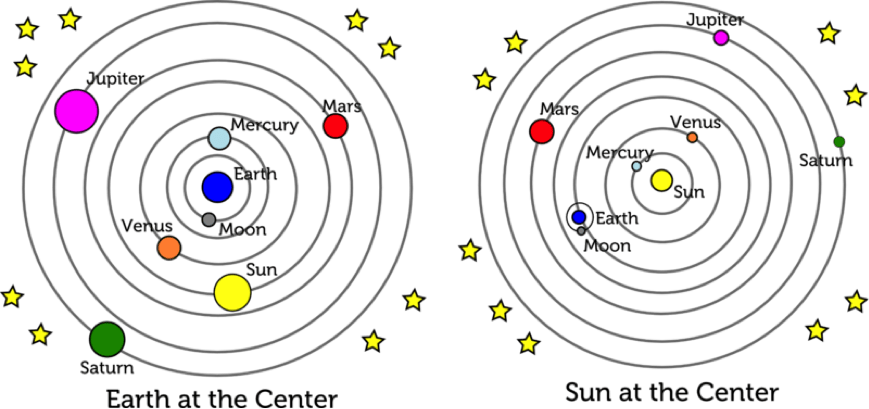In the Middle Ages, European thinking relied on Greek sources that had been transmitted from one generation to the next, and cosmological and astronomical knowledge relied on the writings of Aristotle and Ptolemy.
Aristotle developed a theory of a central Earth surrounded by concentric spherical shells carrying the planets and the stars. Since 13th century, his theory was the basis of European mentality.
At the same time, there was the faith that the Sun, not the Earth, was the center of the Universe. But few were those who saw the advantages of this idea, and most people thought it was physically impossible, since it contradicted Aristotle’s law.
But the change was about to come with the theories of a Polish astronomer, Nicolaus Copernicus. In his work, “De revolutionibus orbium coelestium” (“On the Revolutions of the Heavenly Spheres”), Copernicus suggested the controversial idea that the Sun, not the Earth, was the center of the solar system. The stars were seen as distant celestial objects that do not revolve around the sun. The Earth was assumed to rotate once in 24 hours, causing the stars to appear to revolve around the Earth.
The heliocentric concept was a radical idea for his time. Since nearly all contemporary astronomers had adopted the Greek Earth-centered model (the Greek concept of the Earth as the center of the universe), Copernicus waited until the year of his death to publish his ideas.
Copernicus had two main reasons for asserting that the Sun was the center of our solar system. The first reason was that he considered Ptolemy’s model as being inaccurate. More precisely, while the Ptolemaic model was very good at predicting the positions of the planets, it wasn’t precise, and over the centuries its predictions were becoming increasingly wrong.
The second reason stemmed from the fact that Copernicus didn’t like the fact that the Ptolemaic model was using big epicycles in order to explain the retrograde motions of the planets. Even if he was able to change the idea that the earth is the center of the solar system, he hasn’t questioned the uniform circular motion. Although the Sun was at the center, the planets still executed uniform circular motion. Since the orbits of the planets are not circles, but ellipses, the Copernican model could not explain all the details of planetary motion without epicycles. The difference was that the Copernican system required many fewer epicycles than the Ptolemaic system.
The true motion of the planets around the Sun is not uniform circular motion, which is why the Copernican model also requires the presence of epicycles.
But his theories led to a simple explanation of both the varying brightness of the planets and retrograde motion. The planets in such a system naturally vary in brightness because they are not always the same distance from the Earth. The retrograde motion can be explained in terms of geometry.
Many historians believe that Copernicus had published his theories at the end of his life because he was aware of their controversial nature and feared being ridiculed by his peers and by the church, which had elevated the ideas of Aristotle to the level of religious dogma.
However, this reluctant revolutionary set in motion a chain of events that would eventually produce the greatest revolution in thinking that Western civilization has seen.
His ideas remained rather obscure for about 100 years after his death. But, in the 17th century, the work of Kepler, Galileo and Newton would build on the heliocentric Universe of Copernicus and produce the revolution that led to the annihilation of the ideas of Aristotle and replace them with the modern view of astronomy and natural science.
Copernicus – 100 greatest discoveries:








